With more than 4 million visitors each year, the Cité of Carcassonne is among the most prestigious tourist destinations in France, on a par with Mont Saint Michel and Paris’ Notre-Dame. A UNESCO World Heritage Site since 1997, the walled town perched on a spur above the River Aude is a dramatic representation of medieval architecture. A not-to-miss place when you’re exploring the South of France!
Oh, and before I forget, check out the new Carcassonne Quiz at the end of this post. Its 10 questions will test your knowledge of this amazing destination!
Why the Cité of Carcassonne is worth a visit?
In 2011 Rachel and I went on a tour de France.
Not a cycle race but a real circuit around France.
It was an amazing experience.
A dream come true. To see so many cities, countryside and cultures.
We started in Alsace and went down South via the French Alps. Then we explored Provence and caught a train to Bordeaux and La Rochelle before heading to Paris. We continued our odyssey by Nancy in Lorraine before reaching our starting point in Alsace.
During our Grand Tour, there was one destination that I really really wanted to see.
One of those childhood dreams I wished to fulfil.
CARCASSONNE!

Needless to say, the walled Cité of Carcassonne is one of the most dramatic places to see in France.
It is such an atmospheric medieval fortress town that it inevitably attracts four million visitors each year (well maybe not in 2020-21!)…
On the warm night of summer, the sight of the glowing fairy-tale walled city beautifully illuminated is an unforgettable experience.
![The Cité of Carcassonne at night © Lesueur André - licence [CC BY-SA 4.0] from Wikimedia Commons](https://frenchmoments.eu/wp-content/uploads/2012/11/Carcassonne-©-Lesueur-André-licence-CC-BY-SA-4.0-from-Wikimedia-Commons.jpg)
Add to the local gastronomy cassoulet, Languedoc wines and it’s like heaven on earth!

In 1997 Unesco listed the Cité as a Unesco World Heritage Site – a sign that it’s worth a visit, particularly if you are exploring the South of France.
[Note: I took most of the photos on our 2011 trip with a standard digital camera. This explains the ‘medium quality’ of the photos! I hope you will forgive me for that 🙂 ]
A Brief History of the Cité of Carcassonne
The fortified medieval city dates to the Gallo-Roman era.
First, the Gauls occupied the area in the 6th century B.C.
Then the Romans established a town there and built the ramparts around the 3rd century A.D.
At that time, this small administrative and commercial centre was called Carcaso. It was part of the Roman province Gallia Narbonensis.
Even then, the small town benefited from its advantageous location on the main route between the Mediterranean Sea and the Atlantic Ocean. The Romans called this route the “Via Aquitania”.
However, during the Barbarian Invasions, the inhabitants took refuge on the hill where la Cité stands today.
The Trencavel dynasty
In the 11th century, the powerful Trencavel dynasty of viscounts built the Château Comtal.
Then in the early 13th century, during the Albigensian Crusade, Simon de Montfort besieged and then seized Carcassonne. This move was part of his campaign against the Count of Toulouse. Once he captured the latter, Viscount Raymond Roger Trencavel withdrew into the fortress at Carcassonne and surrendered after 14 days of siege.

The Cité became part of the royal domain of France with the signature of the Treaty of Paris on 12 April 1229. Upon the conditions of the treaty, Viscount Trencavel gave the King of France’s brother, Alphonse de Poitiers, the hand of his only daughter, Jeanne, in marriage. But the son of the deposed viscount rebelled and unsuccessfully laid siege to the fortress with the support of the local gentry.
13th century: the French takeover
In 1246, Raymond Trencavel II accepted the authority of the King of France. Consequently, he publicly relinquished his claim. However, a year later, the viscount broke his seal as a sign of submission. King Louis IX authorised the foundation of a new town (a fortified city) on the other side of the River Aude, below the Cité.
Upon the viscount’s death, Alphonse de Poitiers inherited the countship of Toulouse. However, when he subsequently died with no descendants, the entirety of the South of France permanently passed into the hands of the King of France.
An impregnable fortress
Therefore, in the events of rivalries between the Trencavel family and the French kings, the Cité was heavily fortified. Indeed, fortification efforts to make the Cité impregnable continued throughout the 13th century. This included the construction of a second exterior rampart and the strengthening of the original interior rampart.
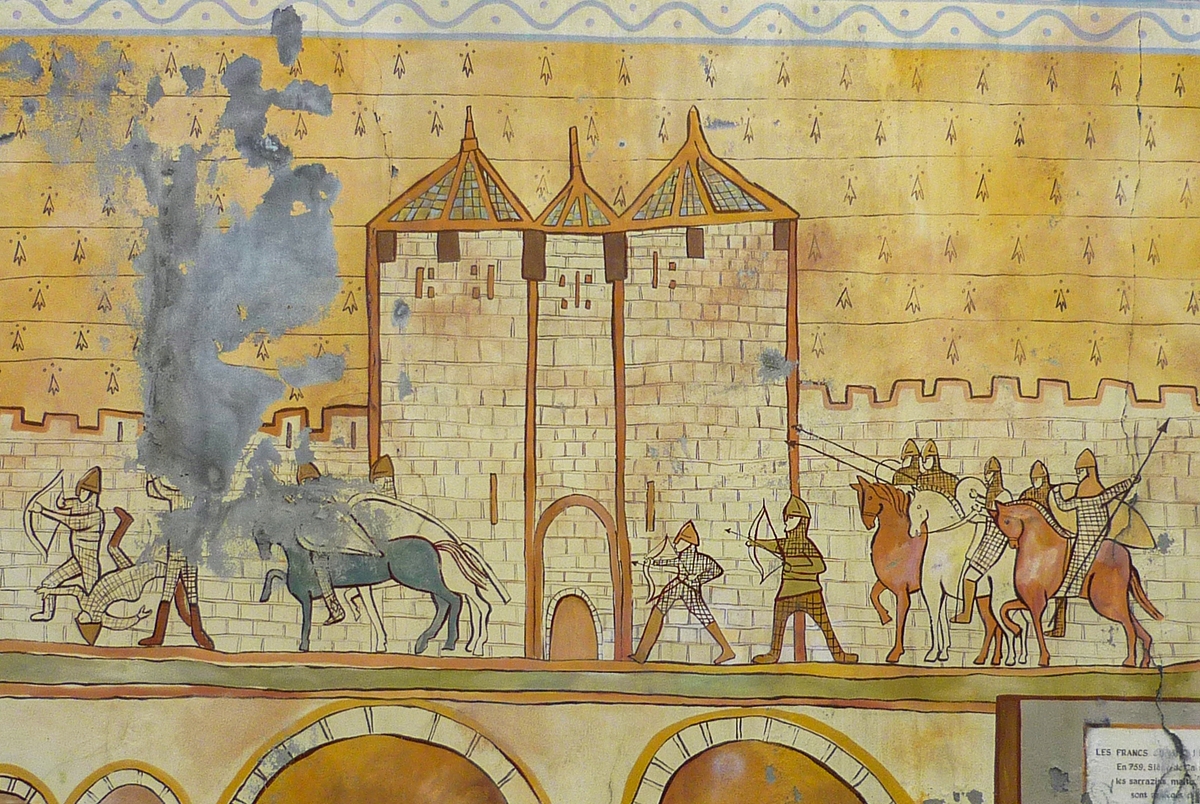
Interestingly, markings from the engineers and artists the king sent from the Île de France are still visible. In fact, significant improvements were undertaken to adapt the fortress to new artillery techniques and deter attackers. In addition, the keep was enlarged to accommodate a permanent garrison.
During the reign of Philip the Bold (King Philip III, 1270-1285), a third major phase of modernisation began. The king had the first inner enclosure rebuilt and the lines of defence strengthened.

So why did the King of France take great care in improving the defence of Carcassonne? For a simple reason: the Cité occupied a strategic position near the border that separated France and Aragon.
The rising of the Lower Town, the Bastide
The signing of the Treaty of the Pyrenees in 1659, formalised peace between France and Spain. It also confirmed the return of Roussillon to French dominion.
Consequently, Carcassonne lost its strategic importance. The Cité was abandoned in favour of the Ville Basse (or Bastide Saint-Louis).
From the 14th to the 18th centuries, the thriving cloth manufacturing industry gave the Ville Basse an economic, urban and administrative expansion. This was at the expense of the Ville Haute (the Upper Town, ie the Cité), where poverty spread.
In the Lower Town, wealthy merchants built opulent private mansions which served as symbols of their success. Distinguished residents, along with the civil, judicial and religious authorities, settled in and contributed to the growth of the new town.
The Cité of Carcassonne falling into disrepair
In 1801, the Basilica of St. Nazaire lost its standing to a new cathedral in the Lower Town.
Unfortunately, the Cité and its defence system fell into disrepair. Napoleon I decommissioned the fortress in 1804. Then in 1820, the War Office relegated it to the list of second-class strongholds.

The great restoration of the Cité of Carcassonne by Viollet-le-Duc
In the 1830s Prosper Mérimée, then inspector of historic monuments reported on the historic and architectural importance of the Cité. Thus, public awareness saved the walled town from destruction.
A decade later, in 1844, architect Viollet-le-Duc began what was to be one of the largest restoration efforts of the 19th century. As with Paris’ Notre-Dame or the Pierrefonds Castle, this restoration (reconstruction?) was carried out in a sometimes controversial manner.

Critics of Viollet-le-Duc’s restoration
Critics especially protested the architect’s choice to restore some of the towers with conical roofs made of slate.
In fact, this is a feature usually found in the North of France. On the contrary, Romanesque red tile is more common in the South of France.
However, Viollet-le-Duc justified his choice based on history. Simon de Montfort and his men, who laid siege to Carcassonne during the Albigensian Crusade, originated from the North of France. Consequently, it was not out of the question that they would have brought architects and engineers with them from the Île de France. The architect reported that pieces of slate had been found at the site during its restoration.
Although the restoration efforts lasted 58 years, Viollet-le-Duc only restored 30% of the Cité.
The discovery of the Cité of Carcassonne
We ascended the hill where the walled town lies via Rue Trivalle that leads to Porte Narbonnaise.
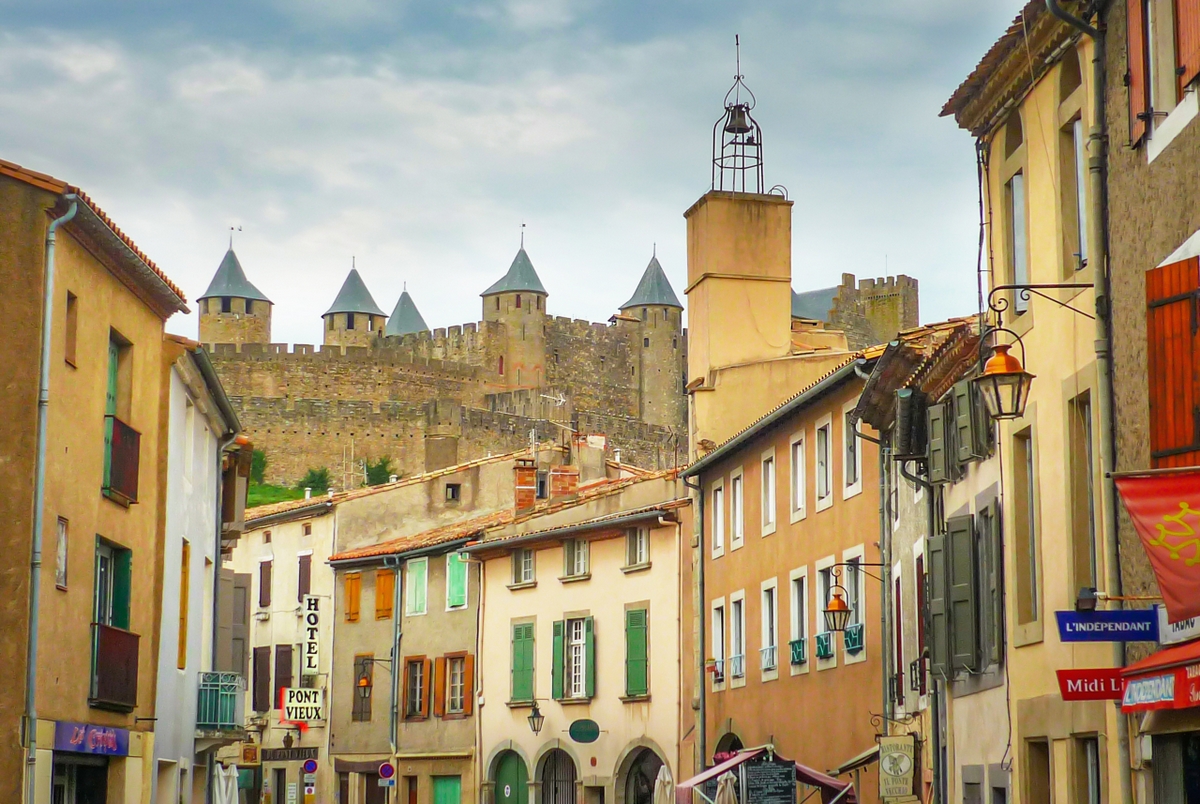
The Cité (the fortified medieval town) is impressively large. It includes:
- a castle (the Château Comtal),
- a basilica (the Basilica of St. Nazaire),
- three kilometres of a double line of ramparts,
- fifty-two towers, and
- several dwellings that house some 100 people.

The castle, fortifications and towers belong to the State of France. The local municipality is responsible for the open-air enclosures between the two walls (lices in French) and the rest of the Cité.
Visiting the Cité of Carcassonne is free, with the exception of the Château Comtal.
You can admire the four entry gates to la Cité, as well as the Basilica of St. Nazaire and the Château Comtal. I do recommend strolling along the lices (ie. the open space between the interior and exterior ramparts).
To visit the Cité of Carcassonne >> Get your Tickets for the castle (including the Remparts Tour) <<
![The Cité of Carcassonne from above © Chensiyuan - licence [CC BY-SA 4.0] from Wikimedia Commons](https://frenchmoments.eu/wp-content/uploads/2012/11/Carcassonne-from-above-©-Chensiyuan-licence-CC-BY-SA-4.0-from-Wikimedia-Commons.jpg)
The Gates of the Cité of Carcassonne
Four gates open access to the Cité:
- Narbonne Gate,
- Saint-Nazaire Gate,
- Aude Gate,
- Rodez Gate.
The Narbonne Gate (Porte Narbonnaise)

Dates back to ca. 1280, during the reign of Philip the Bold.
Opens to the east (towards Narbonne).
From 1859 to 1860, Viollet-le-Duc did much to restore the gate, rebuilding the battlements and the roof in slate and adding a drawbridge that had not originally existed.
Two colossal towers make up the gate. They feature arrow loops designed to deflect enemy fire.
The Saint-Nazaire Gate (Porte Saint Nazaire)

Opens to the south (therefore protecting the adjacent St. Nazaire cathedral which stands 25 m behind the gate).
The gate occupies the square tower of St. Nazaire and involves a complex defence system:
- four watchtowers,
- machicolations,
- portcullises, and
- heavy, reinforced wooden doors.
The platform atop the tower allowed for the positioning of long-range weapons.
Viollet-le-Duc greatly restored the Saint-Nazaire gate between 1864 and 1866.
The Aude Gate (Porte d’Aude)

Opens to the west near the Château Comtal (the gate takes its name from the River Aude, which flows below the Cité)
In the Middle Ages, the Aude Barbican extended the gate. In 1816, the construction of the St. Gimer necessitated the partial demolition of the barbican.
The Aude Gate’s defence system was quite robust. High archways hid false doors that led nowhere, intended to trap attackers!
Also of note are the meandering corridors with various landings. Architects designed them to create a trap in which the enemy would find themselves caught. This allowed the defenders of the Cité to attack from all sides.
Its picturesque medieval look explains why several films have been made here, using the gate as a backdrop.
The Rodez Gate (Porte de Rodez)

Opens to the north (toward the city of Rodez).
The modest Rodez Gate (also known as “Porte du Bourg”) once opened onto the market town of St. Vincent, which no longer exists today.
The gate was dug into the ramparts. The Notre-Dame barbican and the Mourétis Tower once protected access to the Rodez gate.
The legend of Lady Carcas
Most of the visitors will enter the walled town at the Narbonne Gate. There, a statue greets you… let’s find out about who it represents…
Locals maintain the legend of Lady Carcas who was the wife of Ballak, the Muslim prince of Carcassonne (indeed, in the 8th century, the Saracens occupied the region).

Lady Carcas’ trick
Following Ballak’s death at war with Charlemagne, Lady Carcas took the initiative to defend the city against the troops of the Frankish emperor. A cunning lady, she used a trick against the enemy by feeding a pig with a sack of wheat. The animal was then rushed from the highest tower of the town towards the opponents.
In seeing such food waste, Charlemagne thought that the town was still overflowing with food. Consequently, he ordered his army to break camp.
Lady Carcas had saved her city with a trick and immediately decided to ring all the bells, hence the saying: “Carcas sonne!” (Carcas in ringing!). Legend has it that the town takes its name from that event…
It’s only a legend
Well, historians will tell you that this legend is only… a legend. It was Charlemagne’s father, Pepin, who seized the city from the Saracens in 759.
Nevertheless, Lady Carcas personifies the town and it is her statue that welcomes you at the entrance of the walled town, in front of the Narbonne Gate.
The old streets of the walled town
The old town is crisscrossed by narrow winding streets and shady squares of medieval appearance. Some of them are really interesting to explore, but the best time is to go there early in the morning when the crowd of tourists have not made it yet to the site!
The Cité has a number of shops, cafés and restaurants to cater for tourists.
The Basilica of Saint Nazaire
Carcassonne’s former cathedral is an architectural gem.

The first writing mention of the church dates back to 925. Pope Urban consecrated the St. Nazaire and St. Celse cathedral in 1096.
Architects completed the existing gothic structure in the first half of the 12th century. However, it has since been remodelled several times.
The north façade shows a Romanesque portal of five arches over two doors.

The transept and choir are in Gothic style. The church displays some of the finest stained-glass windows in the Languedoc region.
The sanctuary lost its cathedral status to St. Michel Cathedral in the Lower Town in 1801.
In 1898, Pope Leo XIII granted St. Nazaire the title of Basilica.
Viollet-le-Duc largely restored the exterior of the sanctuary in the 19th century.
The Château Comtal
Within the walled town is an imposing castle. It stands against the interior rampart at the hill’s steepest point.

The Château comtal dates back to 1130 when Bernard Ato Trencavel IV commissioned its construction.
A century later the King of France ordered the reconstruction of the castle. He had enhanced lines of defence added between 1228 and 1239.
The quadrangular structure includes nine towers, two of which are of Visigothic origin (the Pinte Tower and the Tour de la Chapelle).
The Pinte Tower, a square watchtower, is the tallest in la Cité.

To the north of the castle is a chapel devoted to Mary with a Romanesque apse.
To visit Carcassonne >> Get your Tickets for the castle (including the Remparts Tour) <<

Visit the Castle

After crossing the access bridge to the castle, visitors arrive in the inner bailey. Fortified structures (12th-18th C.) surround it.
You can buy tickets in two small booths inside the barbican. The entrance of the castle itself is at the end of the stone bridge that runs over a dry ditch. To save time, you can buy your tickets online here.
The inner courtyard is itself an interesting part of the castle.
The chemin de ronde
From the main courtyard, the visit to the castle begins with the “chemin de ronde”. It is the name given to a protected raised walkway behind the ramparts.
The itinerary provides impressive views over the Cour du Midi, the Cité, the Lower Town (Bastide Saint-Louis or Ville Basse). On fair weather, the view extends to the Montagne Noire.
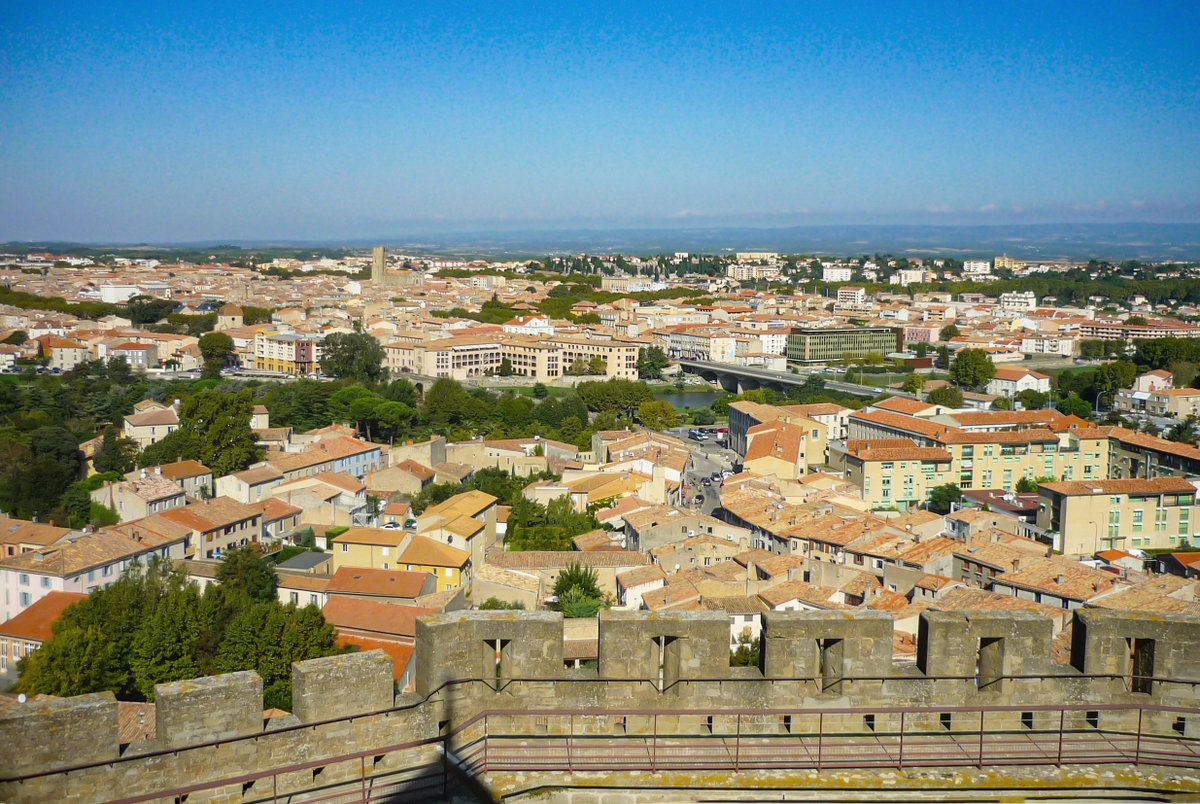
The path goes through a series of wall towers.
Built on top of a segment of the wall, these defensive towers extend outwards slightly, so as to be able to observe the exterior of the walls on either side.
The hoardings
The visitor is led through the hoardings. The defenders used them to launch missiles on several assailants.

These wood galleries were a temporary construction. They were placed on the exterior of the rampart of a castle during a siege. This allowed the defenders to improve their field of fire along the length of the wall. And, most importantly, to fire directly downwards to the wall base!
The medieval hoardings at Carcassonne are one of the few that have survived alongside the keep of Laval. Although they only date back to Viollet-le-Duc’s reconstruction in the 19th century.
Inside the castle
Once inside the castle, Gothic framed windows (late 13th-early 14th C.) divide one of the first main rooms of the castle.

They come from the first floor of the house in the Lower Town that belonged to a man called Grassalio. One can imagine the richness of the Grassalio House and its decoration during that period.
At the beginning of the 17th century, a Franciscan monastery occupied Grassalio’s house. Its demolition took place in the early 20th century (and someone had the brilliant idea to rescue the windows!)

Observe the small columns. It shows beautiful foliate capitals and flowers crowning women’s faces at the bases.
Further on, the visitor passes through a series of rooms with some interesting pieces of art:
- five tombstones from the 14th century,
- old keystones from the 13th century,
- a 12th-century ablution fountain with a decorative strip (called “rinceau”) and twelve mascarons, and
- antique marble sarcophagi.


The room of the keep
The room located in the Trencavel’s keep has a barrel vault decorated with a painting portraying battles between Frankish and Saracen knights.

- You can identify the Franks by their conical helmets and elongated shields, rounded at the top and pointed at the bottom.
- The Saracens are wearing turbans and carry round shields.
- Animals decorate the upper frieze, among which you can see a bird and a blue horse.
This painting was done on dry plaster rather than on fresh plaster like a fresco.
What’s amazing is how Pierre Embry discovered it in 1926 beneath a thick layer of distemper.
The lices of the Cité
Lices is the French word for the open space between the inner and outer walls. They surround the Cité along 3km and you can walk around them for free. It will take you half an hour to one hour, depending on the time you’ll spend taking photos or admiring the view!

In some places, the lices appear to be very wide. The lices walk is an amazing thing to do in Carcassonne as you’ll get close-up views of the ramparts and the pointed-roof towers.
You can access the lices from many points of the Cité, including the four gates (see above).
Montée de la Porte d’Aude
The alley of Montée de la Porte d’Aude connects the Aude Gate to the Aude river and Pont-Vieux via the Rue Barbacanne. You’ll see the austere façade of the Château comtal and the defensive towers with their pointed roofs.


Pont-Vieux and the banks of the Aude
Pont Vieux is an old bridge from the 14th century that spans the River Aude. The car-free bridge offers fantastic views of the perched walled town. The 225 m long bridge was the first one to link the Cité (Upper Town) to the Bastide (Lower Town).

The Gothic chapel of Notre-Dame-de-la-Santé flanks the bridge on the Bastide side.

The banks of the Aude are a great place for picnics.
The Bastide Saint-Louis or Lower Town
The Bastide Saint-Louis, also known as the Lower Town (Ville-Basse) is the administrative and commercial centre of Carcassonne.
Although this part of town is not as old as the Cité, it does date back to the 13th century.
Originally the bastide was surrounded by ramparts. Only a few vestiges remain today. The Jacobins gate is the last of the four original gates that survived.

The centre of the town is Place Carnot adorned with a monumental fountain of Neptune.

In 1247 Saint-Louis ordered the construction of the Saint-Michel cathedral. Viollet-le-Duc restored the Gothic church in the mid-19th century.
![Cité of Carcassonne - Saint-Michel Cathedral © Didier Descouens - licence [CC BY-SA 4.0] from Wikimedia Commons](https://frenchmoments.eu/wp-content/uploads/2012/11/Carcassonne-Cathédrale-St-Michel-©-Didier-Descouens-licence-CC-BY-SA-4.0-from-Wikimedia-Commons.jpg)
When visiting the Bastide Saint-Louis, you’d wrongly think that Saint-Vincent church is the town’s cathedral. It is indeed the largest and highest church of Carcassonne by far. Its bell tower is 54 m tall and dates back to the 14th century, as is the exterior of the church.

And who knows, maybe you’ll encounter some animations in the streets (we saw traditional Catalan dancing)… or attend a pétanque play.
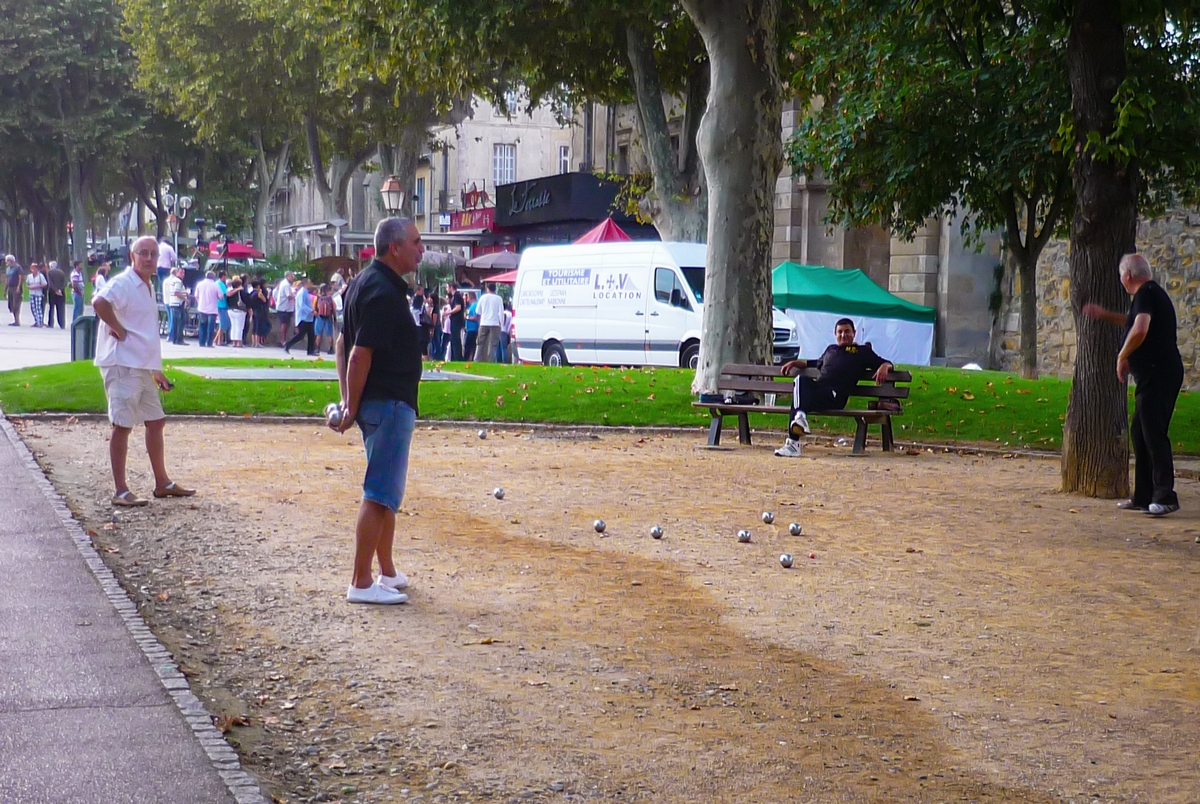
You can also reach the famous Canal du Midi near the railway station.

Movies filmed in the Cité of Carcassonne
The walled town inspired many movie producers for its medieval-looking atmosphere. In particular, the Aude Gate is one of the favourite sites for filming knights’ scenes.
Here’s a little selection (with links to order the movies!)
- Le Corniaud (The Sucker, 1965) by Gérard Oury, starring Louis de Funès and Bourvil
- Robin Hood: Prince of Thieves (1991) by Kevin Reynolds, starring Kevin Costner and Morgan Freeman
- Les Visiteurs (The Visitors, 1993) by Jean-Marie Poiré, starring Jean Reno and Christian Clavier
- The Musketeer (2001) by Peter Hyams, starring Justin Chambers and Catherine Deneuve
- Also, the walled town gave its name to the board game series Carcassonne.
- Want to order a book on Carcassonne? I really enjoy the books from the Ouest-France editions. Check this one out! (and it’s in English!)
Plan your visit to the Cité of Carcassonne: Practical Info
Here’s a little info to organise your next visit to the walled town!
Buy your tickets to the Château Comtal
The visit to the walled town at the top of the hill is free. However, you will need to buy a ticket to visit the Château Comtal. Click on the link below to buy your ticket online and save time on site!
Get your Tickets for the castle (including the Remparts Tour)
Where to stay?
There is a plethora of accommodation for you to choose from… this is no surprise as Carcassonne is one of France’s most visited sites.
This affiliate link will direct you to a list of accommodations in the town of Carcassonne.
You can also navigate through the following map – zoom in/zoom out/go left and right to make the accommodation appear.
Things to do
Click on the following image to access a list of things to do in Carcassonne: private guided tours, Carcassonne day trip from Toulouse, Wine Tasting Tour in Languedoc & more!
Tourist info from the Visitor’s Centre
For more practical info about the Cité of Carcassonne and the surrounding region, you can visit the website of the Tourist Board.
How to get to Carcassonne
By car
The walled town is easily accessible by car from Toulouse, Bordeaux, Avignon and Marseille, as well as from Lyon and Paris thanks to an excellent network of motorways. The A61 motorway links Avignon to Toulouse via Carcassonne.

By air
If you are travelling from Australasia or the Americas, fly to Paris Charles de Gaulle. From there, either rent a car or connect with a train at Gare de Lyon.
There is a small airport near the town (airport website). Ryanair offers service from London Stansted, East Midland, Manchester, Glasgow, Edinburgh, Dublin, Cork and Brussels-Charleroi to Carcassonne-Salvaza Airport.
By train
Trains from Paris-Gare de Lyon run to Narbonne. From where you can take a connecting train to Carcassonne. The walled town lies on the main railway lines between Marseille and Bordeaux via Toulouse. Some TGV from Brussels, Lille, Lyon and Marseille call at Carcassonne.
English-French Vocabulary
![The Cité of Carcassonne and Pont Vieux at dusk © Benh LIEU SONG - licence [CC BY-SA 3.0] from Wikimedia Commons](https://frenchmoments.eu/wp-content/uploads/2012/11/Carcassonne-2-©-Benh-LIEU-SONG-licence-CC-BY-SA-3.0-from-Wikimedia-Commons.jpg)
Albigensian Crusade = Croisade des Albigeois (f)
architecture = architecture (f)
artillery = artillerie (f)
barbican = barbicane (f)
basilica = basilique (f)
castle = château (m)
cathedral = cathédrale (f)
church = église (f)
count = comte (f)
defence system = système de défense (m)
ditch = fossé (m), douve (f)
enemy = ennemi (m)
fortifications = fortifications (f,p)
fortified = fortifié (adj)
fortress = forteresse (f)
garrison = garnison (f)
gate = porte (f)
Gaul = Gaule (f)
heritage = patrimoine (m)
hoardings = hourds (m,f)
keep = donjon (m)
king = roi (m)
kingdom = royaume (m)
knight = chevalier (m)
Lower Town = Ville Basse (f)
medieval = médiéval, médiévale (adj)
Middle-Ages = moyen-âge (m)
Philip the Bold = Philippe le Hardi
Pope = Pape (m)
rampart = rempart (m)
river = rivière (f)
Roman = Romain (m), Romaine (f)
stronghold = place-forte (f)
tower = tour (f)
town = ville (f)
treaty = traité (m)
Upper Town = Ville Haute (f)
viscount = vicomte (m)
wall = mur (m), muraille (f)
walled town = ville fortifiée (f)
Pin it for later
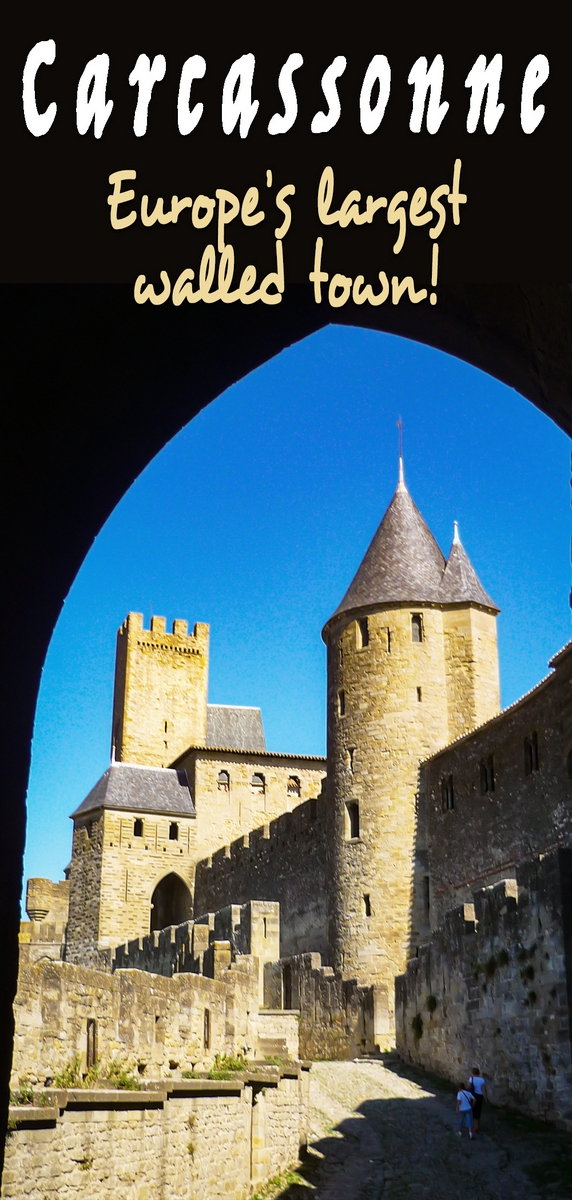
The Carcassonne Quiz
Let’s test your knowledge of Carcassonne now that you’ve been reading this far!


















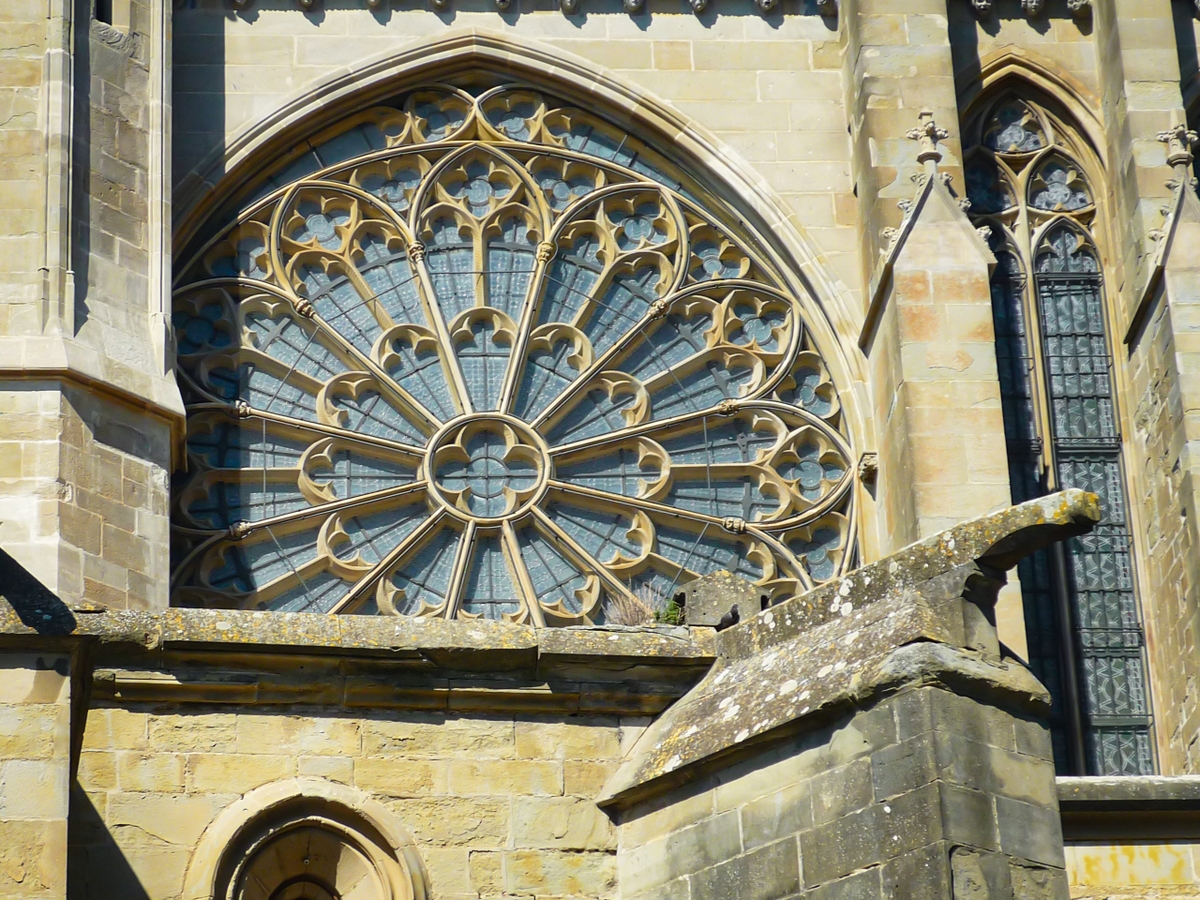















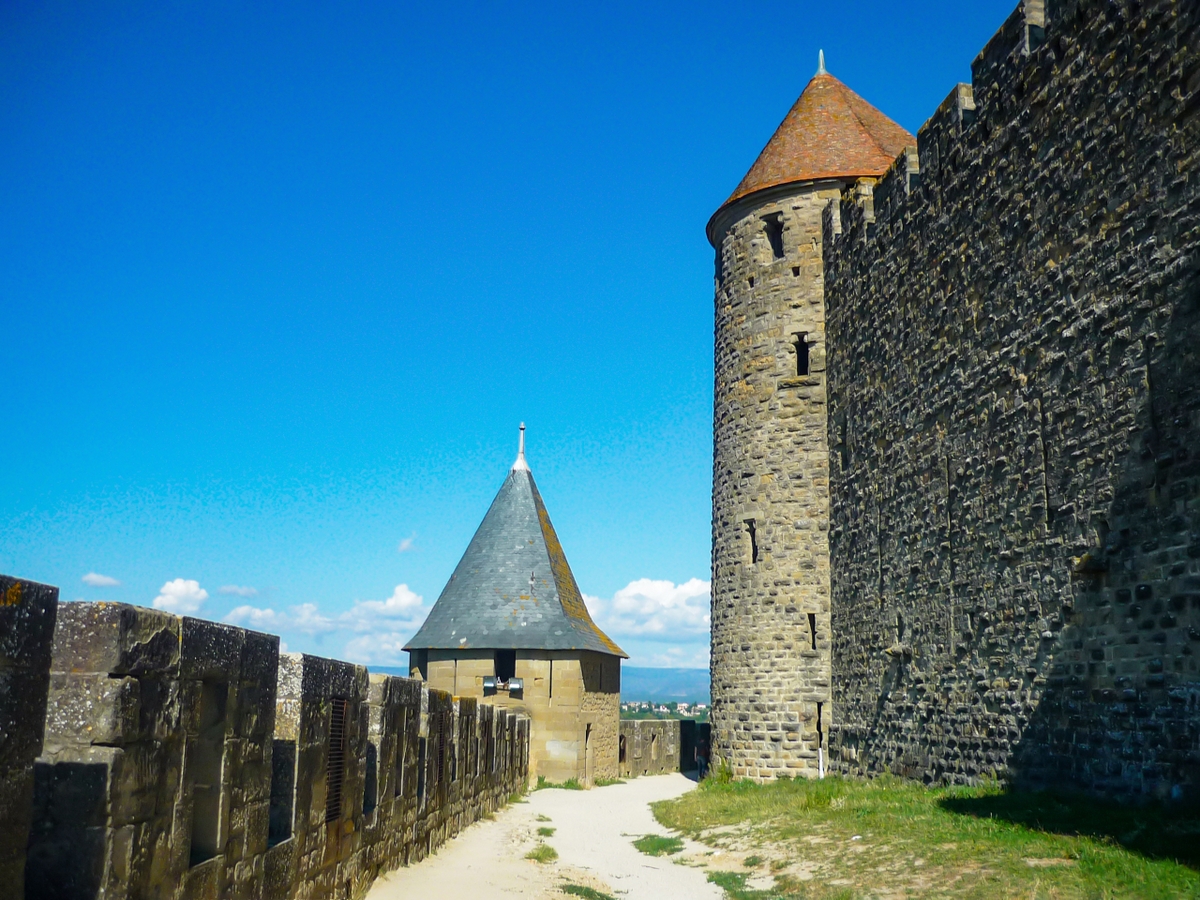



FYI, video at top does not play in Firefox. It does play in Edge.
Thank you Bruce for your comment. I had a go on Firefox and the video did play ok! ?